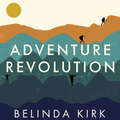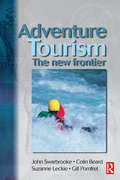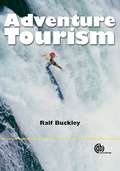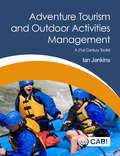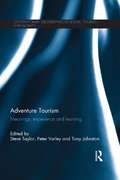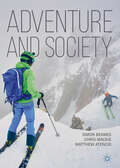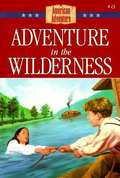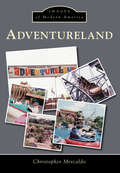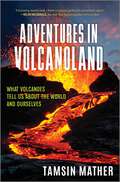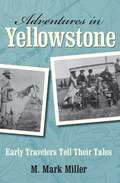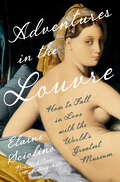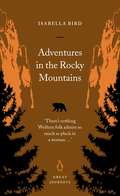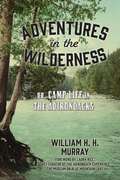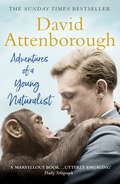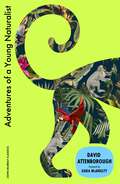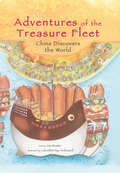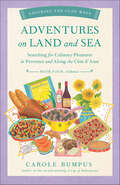- Table View
- List View
Adventure Revolution: The life-changing power of choosing challenge
by Belinda KirkFor the past twenty-five years, Belinda Kirk's professional life has revolved around adventure. She's seen it change people first hand: turning the timid into the confident, the addicted into the recovering, and the lost into the intentionally wandering. As a force for change, adventure can be powerful like few others.This book is about this transformational power, and the first to explore why adventure is essential to our wellbeing. From managing anxiety and overcoming fear, to finding self-worth and building interpersonal connections, to being happier, healthier, and more playful, ADVENTURE REVOLUTION draws lessons from more than two decades of experience leading groups into the wilderness around the globe. Illuminated with Belinda's personal narrative, her own research with modern hunter-gatherers, and the latest findings in neuroscience and behaviour, ADVENTURE REVOLUTION presents a compelling case for ditching the living room in favour of a longer, happier, and more adventurous life.
Adventure Revolution: The life-changing power of choosing challenge
by Belinda KirkFor the past twenty-five years, Belinda Kirk's professional life has revolved around adventure. She's seen it change people first hand: turning the timid into the confident, the addicted into the recovering, and the lost into the intentionally wandering. As a force for change, adventure can be powerful like few others.This book is about this transformational power, and the first to explore why adventure is essential to our wellbeing. From managing anxiety and overcoming fear, to finding self-worth and building interpersonal connections, to being happier, healthier, and more playful, ADVENTURE REVOLUTION draws lessons from more than two decades of experience leading groups into the wilderness around the globe. Illuminated with Belinda's personal narrative, her own research with modern hunter-gatherers, and the latest findings in neuroscience and behaviour, ADVENTURE REVOLUTION presents a compelling case for ditching the living room in favour of a longer, happier, and more adventurous life.
Adventure Tourism
by Colin Beard John Swarbrooke Suzanne Leckie Gill PomfretLooking at the past, present and future of adventure tourism, Adventure Tourism: the new frontier examines the product, the adventure tourist profile, and issues such as supply, geography and sustainability. International case studies are used to illustrate these issues, including: Gorilla watching holidays,Trekking on Mount Everest, Diving holidays, and Outward Bound packages.Analysis of the development and nature of adventure tourism accompanies these studies, ensuring that the title is useful both for undergraduate and postgraduate students of tourism and for professionals involved in managing adventure tourism enterprises.There is also a companion website with additional cases, which can be found at www.bh/com/companions/0750651865.
Adventure Tourism
by Ralf BuckleyAdventure tourism is a new, rapidly growing area at both practical and academic levels. Written at an introductory level, Adventure Tourism provides a basic background and covers commercial adventure tourism products across a range of adventure tourism sectors.
Adventure Tourism and Outdoor Activities Management: A 21st Century Toolkit
by Ian JenkinsAn essential resource for those wishing to understand the driving factors behind the operation of an adventure tourism company, this textbook offers guidance on how to deliver a profitable and sustainable product. The importance of changing markets, technology and corporate social responsibility, including environmental impacts and climate change, are discussed in the context of managing an adventure tourism firm. To remain profitable, companies must address these issues along with the important aspects of risk and safety. Key features include: - Case studies from successful professionals in the industry. - Consideration of the development of sustainable adventure tourism. - Guidance on managing products and customers. Compiled from the author's experience in delivering adventure tourism courses over the last 20 years, this long-awaited book is aimed at both students taking university courses on adventure tourism and outdoor recreation as well as professionals working within the industry.
Adventure Tourism and Outdoor Activities Management: A 21st Century Toolkit
by Ian JenkinsAn essential resource for those wishing to understand the driving factors behind the operation of an adventure tourism company, this textbook offers guidance on how to deliver a profitable and sustainable product. The importance of changing markets, technology and corporate social responsibility, including environmental impacts and climate change, are discussed in the context of managing an adventure tourism firm. To remain profitable, companies must address these issues along with the important aspects of risk and safety. Key features include: - Case studies from successful professionals in the industry. - Consideration of the development of sustainable adventure tourism. - Guidance on managing products and customers. Compiled from the author's experience in delivering adventure tourism courses over the last 20 years, this long-awaited book is aimed at both students taking university courses on adventure tourism and outdoor recreation as well as professionals working within the industry.
Adventure Tourism: Meanings, experience and learning (Contemporary Geographies of Leisure, Tourism and Mobility)
by Tony Johnston Steve Taylor Peter VarleyAdventure tourism is an increasingly widespread phenomenon, appealing to an expanding proportion of the population who seek new destinations and new experiences. This timely, edited volume offers new theoretical perspectives of this emerging subset of Tourism. it uses philosophical and cutting edge empirically grounded research to challenge existing thinking and develop the conceptual framework underpinning definitions of adventure, interrogating the adventure tourism experience and further building upon recent advances in adventure education. The book brings together adventure literature from range of disciplines and applies it to focused study of Adventure Tourism. By doing so it significantly furthers understanding and moves forward this development of this area of Tourism. This significant volume is written by leading academics in the area, and will be valuable reading for all those interested in Adventure Tourism.
Adventure and Society
by Simon Beames Chris Mackie Matthew AtencioThis book provides a broad overview of the ways in which ‘adventurous practices’ influence, and are influenced by, the world around them. The concept of adventure is one that is too often tackled within subject silos of philosophy, education, tourism, or leisure. While much of the analysis is strong, there is little cross-pollination between disciplines. Adventure & Society pulls together the threads of these discourses into one coherent treatment of the term ‘adventure’ and the role that it plays in human social life of the 21st century. It explores how these practices can be considered more deeply through theoretical discourses of capitalism, identity construction, technology and social media, risk-taking, personal development, equalities, and sustainability. As such, the book speaks to a broad audience of undergraduate and postgraduate students across diverse subject areas, and aims to be an accessible starting point for deeper inquiry.
Adventure at High Risk: Stories from Around the Globe
by Cameron Burns Kerry BurnsA collection of some of the world’s greatest adventures Anyone with a thirst for adventure and a courageous spirit will be captivated by the tales of endurance, determination, strength of mind, and perseverance recounted in this outstanding compilation. The stories in this book, be they fact or fiction, represent some of the most gripping and illuminating writing ever penned on the subject of adventure from across the globe. From straightforward narratives to spiritual reveries, adventure prompts men and women to pour forth essays, articles, and books that are unlike any other field of literature. Editors Kerry L. Burns and Cameron M. Burns showcase the amazingly vast spectrum that adventure literature offers.With contributions by:Matt GerdesLinus Lawrence PlattRobyn DavidsonJon TurkCameron M. BurnsDoug PeacockPeter McBrideStephen VenablesRoger W. BruckerRichard A. WatsonChris DavenportJonathan WatermanJohn AckermanDean CummingsChristina DodwellEdmund Stump
Adventure in the Wilderness: The Journey to Cincinnati's Frontier (Barbour Book's The American Adventure, Book #13)
by Veda Boyd JonesEverything is changing. Betsy Miller and her cousin, George Lankford, are moving with their families to the river city of Cincinnati, a journey that will take weeks of traveling on ships, wagons, and flatboats. As they explore America's big cities, meet a Native American, foil a thief's plans, and narrowly escape drowning, Betsy and George just can't seem to get along. Facing one adventure after another in the wilderness, will Betsy and George ever learn to work together?
Adventureland
by Christopher MercaldoSince 1962, Adventureland has been entertaining and thrilling the Long Island community. The park was constructed in a rural area of Suffolk County around the time of a suburban boom eastward on Long Island, which brought enormous population growth in Nassau and Suffolk Counties. Since its opening, the park has seen significant change, with numerous rides and attractions being moved or retired to make way for newer attractions. Published here are images of the park throughout its entire history, many of which have never been seen by the public before. Adventureland shares early lost attractions and retired fan favorites in full living color, allowing both the young and the young at heart to remember the park in all of its stages, from opening to today.
Adventures In Eating
by Clare A. Sammells Helen R. HainesAnthropologists training to do fieldwork in far-off, unfamiliar places prepare for significant challenges with regard to language, customs, and other cultural differences. However, like other travelers to unknown places, they are often unprepared to deal with the most basic and necessary requirement: food. Although there are many books on the anthropology of food, Adventures in Eating is the first intended to prepare students for the uncomfortable dining situations they may encounter over the course of their careers. Whether sago grubs, jungle rats, termites, or the pungent durian fruit are on the table, participating in the act of sharing food can establish relationships vital to anthropologists' research practices and knowledge of their host cultures. Using their own experiences with unfamiliar-and sometimes unappealing-food practices and customs, the contributors explore such eating moments and how these moments can produce new understandings of culture and the meaning of food beyond the immediate experience of eating it. They also address how personal eating experiences and culinary dilemmas can shape the data and methodologies of the discipline. The main readership of Adventures in Eating will be students in anthropology and other scholars, but the explosion of food media gives the book additional appeal for fans of No Reservations and Bizarre Foods on the Travel Channel.
Adventures in Volcanoland: What Volcanoes Tell Us About the World and Ourselves
by Tamsin MatherA mix of memoir, travel and popular science, charting journeys across deserts, through jungles and up ice caps, to some of the most important volcanoes around the world In this captivating book from one of the most influential geochemists in the field, Tamsin Mather takes us along on her globe-spanning excursions from Nicaragua to Hawaii, Santorini to Ethiopia and beyond. With warmth and lyricism, she explores the cultural roles volcanoes play throughout history, and the growing and evolving science behind their formation and eruptions.Adventures in Volcanoland is an urgent and poetic exploration into the world's most mysterious geological mountains and how they make and shape our world.
Adventures in Yellowstone: Early Travelers Tell Their Tales
by M. Mark MillerAfter its establishment in 1872, Yellowstone National Park was sufficiently famous that numerous people risked bear maulings, Indian attacks, and geyser burns just to glimpse its wonders. A surprising number of those who survived wrote about their adventures. The best of these stories are collected in Adventures in Yellowstone. Presenting a dozen narratives—journal entries, letters, and diaries—with an introduction to each, and with historic photographs, postcards, and woodcuts, this book is the essential compilation of the most gripping first-person accounts of the early years of America&’s most cherished national park.
Adventures in the Louvre: How to Fall in Love with the World's Greatest Museum
by Elaine SciolinoA former New York Times Paris bureau chief explores the Louvre, offering an intimate journey of discovery and revelation. The Louvre is the most famous museum in the world, attracting millions of visitors every year with its masterpieces. In Adventures in the Louvre, Elaine Sciolino immerses herself in this magical space and helps us fall in love with what was once a forbidding fortress. Exploring galleries, basements, rooftops, and gardens, Sciolino demystifies the Louvre, introducing us to her favorite artworks, both legendary and overlooked, and to the people who are the museum’s lifeblood: the curators, the artisans producing frames and engravings, the builders overseeing restorations, the firefighters protecting the aging structure. Blending investigative journalism, travelogue, history, and memoir, Sciolino walks her readers through the museum’s front gates and immerses them in its irresistible, engrossing world of beauty and culture. Adventures in the Louvre reveals the secrets of this grand monument of Paris and basks in its timeless, seductive power.
Adventures in the Rocky Mountains (Great Journeys Ser.)
by Isabella BirdEndlessly restless and endlessly curious, Isabella Bird (1831-1904) travelled the world looking for new experiences, but never more delightfully than in her pony-bound adventures in the Colorado Territory at a time when it was only notionally under the control of the American authorities. A vanished world of grizzly hunters, cowboys, isolated cabins and plagues of rattlesnakes is here beautifully brought back to life.Great Journeys allows readers to travel both around the planet and back through the centuries – but also back into ideas and worlds frightening, ruthless and cruel in different ways from our own. Few reading experiences can begin to match that of engaging with writers who saw astounding things: Great civilisations, walls of ice, violent and implacable jungles, deserts and mountains, multitudes of birds and flowers new to science. Reading these books is to see the world afresh, to rediscover a time when many cultures were quite strange to each other, where legends and stories were treated as facts and in which so much was still to be discovered.
Adventures in the Wilderness: Or, Camp Life in the Adirondacks
by W. H.H. MurrayKnown as the &“Father of the Outdoor Movement,&” William HH Murray&’s writings have been appreciated by generations of readers looking to nature as an escape from our daily lives as well as a portal to our past, perhaps none more so than his classic Adventures in the Wilderness: Or, Camp-Life in the Adirondacks. Published in 1869 and widely hailed as the first book on recreational camping ever published in America, this groundbreaking resource informed readers how to live in the woods: what equipment to bring, where to set up camp, how to cook, fish, and hunt, and most importantly insights on the profound connections to be made between humankind and the outdoor world around us. Besides introducing readers to the great outdoors, the book would go on to lay the foundation for the conservation movement. With a Foreword by Laura Rice, the Chief Curator of the Adirondack Experience Museum, this edition of Adventures in the Wilderness revisits Murray&’s timeless tips and stories of north country camping with modern-day context and clarity, showing that the profound power of nature has only grown.
Adventures of a Christmas Elf: The perfect festive family gift from Chief Elf and million-copy selling Ben Miller (Christmas Elf Chronicles #3)
by Ben MillerDiscover the joy of gift giving and meet Santa himself in the perfect stocking filler from the million-copy selling actor, author and comedian, Ben Miller.'Wonderful, funny, magical' Chris Evans'Bubbles with warmth and mischievous humour . . . irresistible' Alexander Armstrong Father Christmas needs a holiday. He isn't feeling well and someone seems determined to ruin the festivities. It's up to Christmas Elves, Tog and Holly, to find a way to deliver the presents on time and bring the Christmas magic back for everyone. A laugh-out-loud race against time from Ben Miller! Discover the magic of life as a Christmas Elf in all three laugh-out-loud stories that will take you round the world on Santa&’s sleigh, including Diary of a Christmas Elf and Secrets of a Christmas Elf. Create the perfect festive bookshelf for all the family with Chief Elf, Ben Miller: Meet Santa himself in The Night I Met Father Christmas, a brand-new picture book for 3+ readers, illustrated by Elisa Paganelli. Join the toy workshop as a Christmas Elf in all three pocket-sized stocking fillers for 7+ readers: Diary of a Christmas Elf, Secrets of a Christmas Elf, and Adventures of a Christmas Elf. See where it all began, in Ben Miller's first ever novel, The Night I Met Father Christmas, a classic festive read for 8+ readers.
Adventures of a Continental Drifter: An Around-the-World Excursion into Weirdness, Danger, Lust, and the Perils of Street Food
by Elliott HesterIn October 2002, Elliott Hester sold his car, abandoned his apartment, and took off alone on a trip around the world, during which he drifted to over fifty destinations. Elliott's tales about his travels range from the bizarre to the hilarious to the flat-out shocking. Travel with him as he:· Chases off transvestites in the South Pacific· Gets drunk on Estonian moonshine at the maker's eightieth birthday party· Impersonates Samuel L. Jackson at the 38th International Film Festival in the Czech Republic · Ponders the Finnish tradition of sprinting from steamy sauna to plunge into the frigid Baltic Sea—naked!· And much more.Only an around-the-world excursion could produce such outlandish, hair-raising, hysterical adventures. And only Elliott Hester could make such vivid observations and write such vibrant insights about life---and people---on the road.
Adventures of a Young Naturalist: SIR DAVID ATTENBOROUGH'S ZOO QUEST EXPEDITIONS
by Sir David AttenboroughTHE SUNDAY TIMES BESTSELLER'A great book for anyone who wants to vicariously travel like an old-fashioned adventurer and seeks to understand how far we have come in developing a protective attitude to wildlife' New York Times'A marvellous book ... unputdownable ... utterly engaging' TelegraphIn 1954, a young television presenter named David Attenborough was offered the opportunity of a lifetime - to travel the world finding rare and elusive animals for London Zoo's collection, and to film the expeditions for the BBC. Now 'the greatest living advocate of the global ecosystem' this is the story of the voyages that started it all. Staying with local tribes while trekking in search of giant anteaters in Guyana, Komodo dragons in Indonesia and armadillos in Paraguay, he and the rest of the team battled with cannibal fish, aggressive tree porcupines and escape-artist wild pigs, as well as treacherous terrain and unpredictable weather, to record the incredible beauty and biodiversity of these regions. The methods may be outdated now, but the fascination and respect for the wildlife, the people and the environment - and the importance of protecting these wild places - is not.Written with his trademark wit and charm, Adventures of a Young Naturalist is not just the story of a remarkable adventure, but of the man who made us fall in love with the natural world, and who is still doing so today.
Adventures of a Young Naturalist: SIR DAVID ATTENBOROUGH'S ZOO QUEST EXPEDITIONS
by Sir David AttenboroughWITH A NEW FOREWORD BY DARA McANULTYTHE SUNDAY TIMES BESTSELLER'His writing is as impressive and as enjoyable as his TV programmes and there can be no higher praise' Daily Express'A marvellous book . . . unputdownable . . . utterly engaging' Daily TelegraphIn 1954, a young television presenter named David Attenborough was offered the opportunity of a lifetime - to travel the world finding rare and elusive animals for London Zoo's collection, and to film the expeditions for the BBC.Now 'the greatest living advocate of the global ecosystem' this is the story of the voyages that started it all. Staying with local tribes while trekking in search of giant anteaters in Guyana, Komodo dragons in Indonesia and armadillos in Paraguay, he and the rest of the team battled with cannibal fish, aggressive tree porcupines and escape-artist wild pigs, as well as treacherous terrain and unpredictable weather, to record the incredible beauty and biodiversity of these regions. The methods may be outdated now, but the fascination and respect for the wildlife, the people and the environment - and the importance of protecting these wild places - is not.Written with his trademark wit and charm, Adventures of a Young Naturalist is not just the story of a remarkable adventure, but of the man who made us fall in love with the natural world, and who is still doing so today.** Praise for Sir David Attenborough **'A great educator as well as a great naturalist' Barack Obama'Sir David is a wizard of television, and, like Gandalf or Dumbledore, he has a near-magical gift for combining warmth and gravitas . . . the man who, for me, exemplifies the best in British broadcasting' Louis Theroux'When I was a young boy I used to love turning on the television and watching David's programmes and really feeling like I was either back out in Africa or I was learning about something magical and almost out of this planet' Prince William
Adventures of a Young Naturalist: SIR DAVID ATTENBOROUGH'S ZOO QUEST EXPEDITIONS
by Sir David AttenboroughWITH A NEW FOREWORD BY DARA McANULTYTHE SUNDAY TIMES BESTSELLER'His writing is as impressive and as enjoyable as his TV programmes and there can be no higher praise' Daily Express'A marvellous book . . . unputdownable . . . utterly engaging' Daily TelegraphIn 1954, a young television presenter named David Attenborough was offered the opportunity of a lifetime - to travel the world finding rare and elusive animals for London Zoo's collection, and to film the expeditions for the BBC.Now 'the greatest living advocate of the global ecosystem' this is the story of the voyages that started it all. Staying with local tribes while trekking in search of giant anteaters in Guyana, Komodo dragons in Indonesia and armadillos in Paraguay, he and the rest of the team battled with cannibal fish, aggressive tree porcupines and escape-artist wild pigs, as well as treacherous terrain and unpredictable weather, to record the incredible beauty and biodiversity of these regions. The methods may be outdated now, but the fascination and respect for the wildlife, the people and the environment - and the importance of protecting these wild places - is not.Written with his trademark wit and charm, Adventures of a Young Naturalist is not just the story of a remarkable adventure, but of the man who made us fall in love with the natural world, and who is still doing so today.** Praise for Sir David Attenborough **'A great educator as well as a great naturalist' Barack Obama'Sir David is a wizard of television, and, like Gandalf or Dumbledore, he has a near-magical gift for combining warmth and gravitas . . . the man who, for me, exemplifies the best in British broadcasting' Louis Theroux'When I was a young boy I used to love turning on the television and watching David's programmes and really feeling like I was either back out in Africa or I was learning about something magical and almost out of this planet' Prince William
Adventures of the Treasure Fleet
by Ann Martin Bowler L. K. Tay-AudouardDid you know that 85 years before Columbus discovered America, Chinese ships longer than a football field sailed thousands of miles through unknown oceans and visited more than 30 nations? It's true! Adventures of the Treasure Fleet is the amazing story of these seven epic voyages and their larger-than-life commander, Admiral Zheng He.Beginning in 1405, Admiral Zheng He led more than 300 gigantic, brightly-painted ships across the South China Sea to the Indian Ocean and all the way to the distant coast of Africa. The admiral and his crew battled pirates and raging storms, and were amazed by the people and ways of life in distant lands. At each port, Chinese goods were traded for pearls, precious stones, herbs and medicines which were given as tribute to China's powerful emperor when the ships' returned home.Filled with historical facts, Adventures of the Treasure Fleet brings a fantastic piece of history to life. Gracefully told and beautifully illustrated, the story's fast pace will keep young ones captivated while offering enough information to satisfy curious readers of all ages.
Adventures of the Treasure Fleet
by Ann Martin Bowler L. K. Tay-AudouardDid you know that 85 years before Columbus discovered America, Chinese ships longer than a football field sailed thousands of miles through unknown oceans and visited more than 30 nations? It's true! Adventures of the Treasure Fleet is the amazing story of these seven epic voyages and their larger-than-life commander, Admiral Zheng He.Beginning in 1405, Admiral Zheng He led more than 300 gigantic, brightly-painted ships across the South China Sea to the Indian Ocean and all the way to the distant coast of Africa. The admiral and his crew battled pirates and raging storms, and were amazed by the people and ways of life in distant lands. At each port, Chinese goods were traded for pearls, precious stones, herbs and medicines which were given as tribute to China's powerful emperor when the ships' returned home.Filled with historical facts, Adventures of the Treasure Fleet brings a fantastic piece of history to life. Gracefully told and beautifully illustrated, the story's fast pace will keep young ones captivated while offering enough information to satisfy curious readers of all ages.
Adventures on Land and Sea: Searching for Culinary Pleasures in Provence and Along the Côte d'Azur (Savoring the Olde Ways Series)
by Carole BumpusFans of Peter Mayle and Janine Marsh will enjoy this exploration of medieval villages, cultures, and recipes of France’s Provence. This travelogue is Book 4 in the author’s best-selling series, which has won the IPPY gold medal for Best Culinary Travel Series.Join Carole Bumpus, her husband, Winston, and their friends in Book Four of Savoring the Olde Ways, her culinary-travel series. Following in the footsteps of writer Peter Mayle, Bumpus is on a quest to find the real Provençe. On three separate excursions—from Nice to Nîmes, Moustiers to Marseilles, and San Tropez to San Remy—and while sailing along the Côte d’Azur, she invites you to join her in uncovering the mysteries of Provençe. Are they hidden within their myths, festivals, or traditions? Is it possible they’re veiled in the sheer beauty of the land and sea? Could they be concealed in Roman arenas in Arles, Orange, or Glanum? Or, perhaps, within the ancient methods of traditional cooking or winemaking? Maybe they are hidden in plain sight among the locals who open their hearts, their bistros, and homes to strangers. Yes, you may find it in chefs while cooking in ancient kitchens, in the smile of the shy barmaid who speaks no English, in the giggle of the Pizza Wagon baby, in the agreeable village baker, or in the patient waiter and harbor master—but you will most especially experience it through friends who fling open their doors to share their families’ recipes. Traveling alongside Bumpus, that is where you’ll discover the real Provençe.

